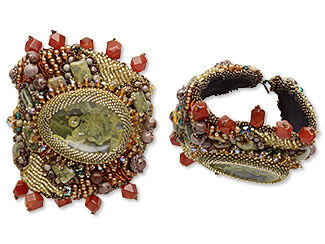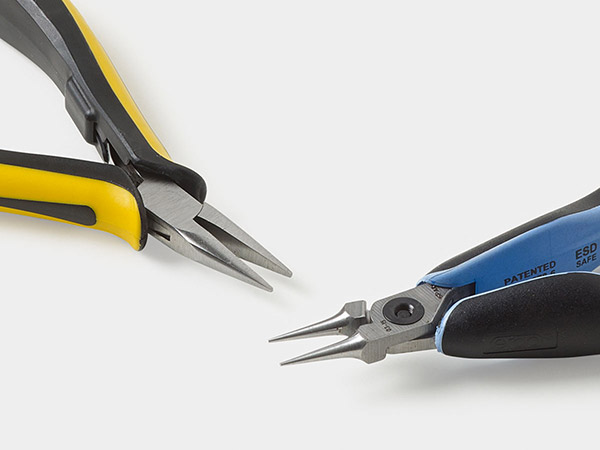Geek Chic Jewelry: Part 5 - Jewelry for Science!
This jewelry style is for those people who see science as art or just happen to be passionate about the pursuit of knowledge. These necklaces, bracelets, rings and more show off your scientific interests such as chemistry and biology. Let your geek flag fly with jewelry for science nerds that would make Bill Nye the Science Guy, Miss Frizzle and Mister Wizard proud.
Go Viral
Spread your love of science by wearing cell-inspired shapes. Bacteriophages are a popular—and interesting— shape often cast, poured or molded in metal clay. The bacteriophage, sometimes called phage or bacterial virus, infects bacteria— which is great when bacteria production needs to be halted. Amoebas are another interesting design feature seen in jewelry, such as this eye-catching Gem Amoeba Cuff by Betty Neve, entered into one of our gemstone contests. A cabochon serves as the nucleus while other beads represent various vacuoles, pseudopods and more. Amoebas can change their shape, so you have a lot of creative license with these cells.
Another fun way to add a bit of biological inspiration to your designs is to use beads that look like microscopic creatures. Millefiori beads in bacteriological greens and yellows resemble specimens grown and studied in Petrie dishes, making germ-tastic jewelry.
It's Not Brain Surgery
Don't rack your brain, just start at the beginning, literally where all your thoughts and movements begin. The brain is an amazing web of neurons, resembling intricate tree branches and roots, making wire wrapping the perfect jewelry medium for replicating it. Neurons process and transmit information through electrical and chemical signals. These fascinating signals have inspired charm and pendant designs, showcasing molecules like serotonin, dopamine, acetylcholine, caffeine and adrenaline. Cindy Holsclaw made her own Endorphin Molecule collar necklace with seed and bugle beads for a Bead Dreams contest.
We've Got Chemistry, Baby
The Periodic Table of the Elements is showing up on large cuff bracelets, while individual elements are made into pendants, rings or post earrings. It's especially fun to render certain elements in their actual material or color like Au (gold) in 22Kt gold metal clay or Ag (silver) in silver precious metal clays. Make non-metallic elements like Ne (Neon) with polymer clay to add some color. Combine elements in a row or column to spell out words. For instance, Nitrogen, Erbium and Dysprosium spells "NErDy," and Germanium, Nickel, Uranium and Sulphur spells "GeNiUS." Of course, flasks and beakers are present in chemistry-related jewelry, sometimes with unit measurements, enamel color representing the contents inside or even just the shape stamped with a heart.
Born This Way
Flaunt what your mother (and father) gave you with jewelry inspired by what you're made of. DNA (deoxyribonucleic acid) is the building block of life, so why not of jewelry? Try using seed beads for a Strands of Life necklace or colorful bugle beads to represent adenine, thymine, guanine and cytosine inside the twisting backbone. We've seen rings and bangle bracelets made from metallic ribbons of DNA, too. Other jewelry creations along this same line include chromosomes, which look like a squished X and carry genetic information. Lastly, we've seen phylogenetic trees (sometimes referred to as evolutionary trees) made from wire or etched on round metal discs. Phylogenetic trees are branching diagrams that show the relationships of biological species based on similarities or differences in their physical and genetic characteristics.
Let's Get Physics-al
Atoms are the basic unit of any chemical element and can produce huge amounts of energy for being so incredibly tiny. This shape became extra popular in part, no doubt, to its inclusion in the logo for the popular comedic TV show The Big Bang Theory. Atoms are fun to create in jewelry as three-dimensional shapes with wire and colored beads as neutrons (subatomic particles with no electric charge), protons (subatomic particles with positive charges) and electrons (subatomic particles with negative charges). Flat representations have been seen in acrylic or metal with flat-back rhinestones as the corresponding particles.
We didn't cover all the fields of science, including astronomy (planets and constellations) and some mathematics studies (pi and the Fibonacci sequence), which could inspire some fascinating jewelry as well. Pick your favorite field, or find out what scientific inquiries your customers are interested in. You can even be more generic by using the words "science," "STEAM" (Science, Technology, Engineering, Arts, Mathematics) and "I love science" stamped on a blank or in blocky acrylic letters. These are just a few ideas to get you thinking about combining science with your artistic abilities for intriguing and marketable results.
Previous: Part 4 - Anime | Next
Shop for Your Materials Here:
Have a question regarding this project? Email Customer Service.
Copyright Permissions
All works of authorship (articles, videos, tutorials and other creative works) are from the Fire Mountain Gems and Beads® Collection, and permission to copy is granted for non-commercial educational purposes only. All other reproduction requires written permission. For more information, please email copyrightpermission@firemtn.com.











